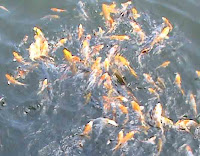New Koi Fish can be carrying parasites, and in rare cases systemic infections (internal problems) and although the Japanese breeders and koi dealers in the U.K. normally treat fish when they first arrive, there is no guarantee that problems will not occur after you have purchased your koi. The induced stress of their long journey, and radically different water quality can inhibit the immune system response in newly arrived koi fish. This can lead to parasite attacks , and ultimately bacterial infections.
However, we should bear in mind that the vast majority of koi are strong and healthy when they are first harvested in Japan, and are not riddled with parasites or infection. Most problems occur because of the induced stress of up to 24 hours in a plastic bag during transit to the U.K, and because of substantially differing water conditions, in particular pH and general hardness.
During the journey, your new koi has almost certainly been subjected to water temperature changes of 15 deg. C over a 24 hour period which adds to the stress problem.
Therefore, rather than treating problems after they occur, we need to get the koi 'comfortable' in their new environment as quickly as possible, to ensure that their own immune system is working properly, so that they can fight of any potential problems without human intervention.
Many people run into self induced problems when quarantining new fish simply because they are unaware of the level of aftercare required for their new purchase and assume their new Koi will look after itself. The single most common cause of problems in our view is quarantining fish in a vat or pond which is too small.
There is a well publicised view that a quarantine facility of between 250 - 500 gallons is adequate for quarantine purposes. This may be the case if you only have 4 or 5 small koi to quarantine, but not for anything else.
In our view your quarantine facility should be minimum 1000 gallons with temperature control and a mature filter. Setting up you quarantine facility 3 weeks before the fish are due to arrive is asking for trouble.
Do's and Don'ts Quarantine Koi Fish
1. Do have your quarantine facility ready for the job, the larger the better with a mature filter.
2. Do carry out regular water changes.
3. Do monitor for ammonia and nitrite regularly.
4. Do take scrapes to ensure an appropriate treatment regime.
5. Do observe your new koi's behaviour
6. Do provide adequate aeration.
7.Don't quarantine your new prize 26" koi in 500 gallons of water!
8. Don't use chemicals on your new arrivals until they have settled in.
9. Don't use dips - they are very stressful and not particularly effective.
10.Don't quarantine single fish - koi are gregarious and are happiest with company.
11.Don't use chemicals indiscriminately - use an appropriate remedy for the specific problem encountered.
12.Don't subject your koi to fluctuating temperatures or other water parameters.
13. Don't overfeed the Koi, - once per day @ 17 deg C is quite adequate.
We recommend the following quarantine regime
1. Adequate facility, mature filter, temperature controlled.
2. Five days before new fish arrive dose quarantine pond with chloramine T or Virkon S to disinfect and reduce bacteria count.
3. Carry out 10-20% water change immediately prior to arrival of new stocks.
4. Introduce new fish and allow to settle in for minimum 3 days. During this period, use only salt at 0.5 oz per gallon and or Elbagin as a supportive treatment to help koi overcome stress. No other chemicals.
5 Take scrapes of selected koi and check for parasites.
6. Apply appropriate parasite treatment if required.
7. Maintain adequate aeration through the period of treatment.
8. Retake scrapes at the end of your parasite treatment. and re-dose if necessary.
9. Dose pond with chloramine T to reduce bacteria count.
10. Continue to carry out regular (at least every 5 days) 10% water changes.
11. Monitor for ammonia and nitrite readings regularly.
12. Maintain a stable temperature. (17.5 deg C or 64 deg F is recommended)
Source:
http://www.koicarp.org.uk/quarantine.htm
